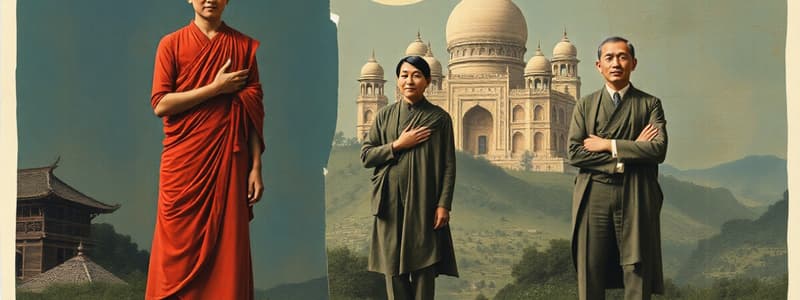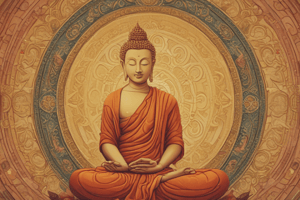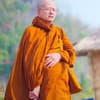Podcast
Questions and Answers
What was the primary objective of Faxian's pilgrimage to India?
What was the primary objective of Faxian's pilgrimage to India?
- To visit and document various pilgrimage sites
- To establish trade routes between China and India
- To seek alliances with Indian rulers
- To procure texts related to monastic rules (Vinaya) (correct)
Xuanzang received explicit permission from the Tang court before embarking on his pilgrimage to India.
Xuanzang received explicit permission from the Tang court before embarking on his pilgrimage to India.
False (B)
What crucial role did Chinese pilgrims play in the exchange between ancient India and China?
What crucial role did Chinese pilgrims play in the exchange between ancient India and China?
They introduced new texts and doctrines to the Chinese clergy, carried Buddhist paraphernalia, and provided detailed accounts of their spiritual journeys to India.
According to Faxian, the growing Buddhist community in China was aware of the ______ of texts essential for the establishment and proper functioning of monastic institutions.
According to Faxian, the growing Buddhist community in China was aware of the ______ of texts essential for the establishment and proper functioning of monastic institutions.
Match each Chinese pilgrim with a unique aspect of their journey or writings:
Match each Chinese pilgrim with a unique aspect of their journey or writings:
What term did Xuanzang determine to be the correct Chinese term for India?
What term did Xuanzang determine to be the correct Chinese term for India?
Yijing's works have garnered significant attention from students and scholars of Asian and world history, making them among the most studied of the Chinese pilgrims.
Yijing's works have garnered significant attention from students and scholars of Asian and world history, making them among the most studied of the Chinese pilgrims.
What was the central focus of Yijing's 'The Record of Buddhism As Practiced in India Sent Home from the Southern Seas'?
What was the central focus of Yijing's 'The Record of Buddhism As Practiced in India Sent Home from the Southern Seas'?
Faxian's account contributed to the Chinese perception of India as a sophisticated and culturally ______ society.
Faxian's account contributed to the Chinese perception of India as a sophisticated and culturally ______ society.
What did Faxian observe in Loulan regarding cultural influences?
What did Faxian observe in Loulan regarding cultural influences?
Xuanzang's records of India's geography, climate, and social systems are considered unreliable due to his strong religious bias.
Xuanzang's records of India's geography, climate, and social systems are considered unreliable due to his strong religious bias.
How did Buddhist monasteries benefit long-distance traders, according to the provided material?
How did Buddhist monasteries benefit long-distance traders, according to the provided material?
Xuanzang's narrative known as 'The Records of the Western Regions Visited During the Great Tang Dynasty' was intended for his ______ patrons as much as it addressed the contemporary Chinese clergy.
Xuanzang's narrative known as 'The Records of the Western Regions Visited During the Great Tang Dynasty' was intended for his ______ patrons as much as it addressed the contemporary Chinese clergy.
What was the main reason why Xuanzang criticized available translations of Buddhist works in China?
What was the main reason why Xuanzang criticized available translations of Buddhist works in China?
According to Yijing, the use of chopsticks was a universally accepted practice in all parts of India during his time.
According to Yijing, the use of chopsticks was a universally accepted practice in all parts of India during his time.
Flashcards
Faxian, Xuanzang, and Yijing
Faxian, Xuanzang, and Yijing
Chinese pilgrims who documented their spiritual journeys to India, providing accounts of Indian society, monastic institutions, and Buddhist practices.
Travel records of Chinese Pilgrims
Travel records of Chinese Pilgrims
Records that offer historical insights into Buddhist doctrines, social and political conditions, cross-cultural perceptions, long-distance travel, and commercial exchanges between China and India.
Faxian's main purpose for traveling to India
Faxian's main purpose for traveling to India
The primary objective was to acquire texts related to monastic rules (Vinaya) due to their scarcity in China during the 3rd and 4th centuries.
Faxian's experiences in Central Asia
Faxian's experiences in Central Asia
Signup and view all the flashcards
Faxian's travel record focuses on
Faxian's travel record focuses on
Signup and view all the flashcards
Xuanzang
Xuanzang
Signup and view all the flashcards
The Records of the Western Regions Visited During the Great Tang Dynasty
The Records of the Western Regions Visited During the Great Tang Dynasty
Signup and view all the flashcards
Xuanzang's dissatisfaction with translated texts
Xuanzang's dissatisfaction with translated texts
Signup and view all the flashcards
Yijing's goal in recording monastic rules.
Yijing's goal in recording monastic rules.
Signup and view all the flashcards
Memoirs of Eminent Monks
Memoirs of Eminent Monks
Signup and view all the flashcards
Xuanzang's preferred name for India
Xuanzang's preferred name for India
Signup and view all the flashcards
Result of Xuanzang's meeting with Harșavardhana.
Result of Xuanzang's meeting with Harșavardhana.
Signup and view all the flashcards
Purpose of Pilgrims' narratives.
Purpose of Pilgrims' narratives.
Signup and view all the flashcards
Pilgrims' attempt to recreate Indic world in China
Pilgrims' attempt to recreate Indic world in China
Signup and view all the flashcards
Study Notes
- The spread of Buddhist doctrines from India to China beginning in the first century CE triggered cross-cultural exchanges that impacted Asian and world history.
- Buddhist monks and pilgrims traveling, along with the circulation of religious texts and relics, spurred interactions between Indian kingdoms and China, influencing those in Central and Southeast Asia.
- The transmission of Buddhist doctrines from India to China involved societies, missionaries, traders, artisans, and medical professionals.
Chinese Pilgrims Role
- Chinese pilgrims played a pivotal role in exchanges between ancient India and China, introducing new texts and doctrines to the Chinese clergy.
- They carried Buddhist paraphernalia for rituals and provided detailed accounts of spiritual journeys to India, also providing detailed accounts of Indian society and its rulers.
- Travel records from Chinese pilgrims mention flourishing monastic institutions, in addition to stories of the Buddha's magical prowess
- These records shaped a unique perception of India among the Chinese clergy with some viewing it as a sacred, Utopian realm inhabited by civilized people.
- This elevated the Chinese perception of Indian society and discourse with foreign peoples who were commonly regarded as barbaric.
- Faxian, Xuanzang, and Yijing, among hundreds of Chinese monks, made pilgrimages to India, and their detailed accounts became historically significant.
Travel Records Importance
- Travel records provide accounts of Buddhist doctrines, rituals, and monastic institutions in South, Central, and Southeast Asia.
- Travel records include information about social and political conditions in South Asia and kingdoms between China and India.
- These accounts offer insights into cross-cultural perceptions, interactions, the challenges of long-distance travel, commercial exchanges, and the pilgrim-merchant relationship.
Faxian's Journey and Impact (337?-422?)
- Faxian was among the oldest Chinese monks to travel to India, embarking in 399 from Chang'an (Xi'an) at over sixty years old to retrieve Vinaya texts.
- Faxian trekked across the Taklamakan desert, visited major Buddhist sites in India and Sri Lanka, and returned to China via a sea route after fourteen years.
- Procurement of Vinaya texts was the main goal for his trip, underscoring the need for monastic rule texts in China at the time.
- Though important Buddhist texts were translated into Chinese, the Buddhist community was aware of the shortage of texts essential for monastic institutions.
- Faxian encountered multiethnic societies in Central Asia, such as Loulan, where people dressed like the Chinese but followed Indian customs.
Faxian's Account Details
- The account includes descriptions of local monasteries, monk numbers, teachings, rituals, and Buddhist legends associated with sites.
- Faxian highlights the Buddhist practices he encountered at the sites he visited, including the locations of the Buddha's conception and attainment of nirvana.
- He also witnessed rituals associated with the worship of the Buddha's alms-bowl and the elaborate ceremony to venerate the Buddha's tooth, details which contributed to similar ceremonies in China.
- These accounts triggered a demand for bodily remains and ritual objects, resulting in a unique network for circulating Buddhist doctrines and items between South and East Asia.
- The network of trade benefitted Buddhist monks and traders, where the Monks often hitchhiked on caravans or ships, and traders profited from the demand for Buddhist commodities.
- Buddhist monasteries provided accommodations and healthcare to traders who gave donations to the monastic communities.
- He traveled on a mercantile ship from Tamralipti to Sri Lanka in 408 or 409, and again boarded a vessel to return to China, demonstrating the relationship between monks and traders, and the existence of maritime routes.
- Maritime travel between southern Asia and China was perilous.
Record of Buddhist Kingdoms
- A Record of the Buddhist Kingdoms was the first eyewitness account of Buddhist practices and pilgrimage sites in Central and South Asia.
- It contributed to a unique perception of India among the Chinese clergy with some considering India a holy land.
- Daozheng, a Chinese monk, decided to remain in India due to the moving Buddhist sites and institutions, wishing to not be reborn in China ever again.
- The Chinese perception of India as culturally advanced, is highlighted by Li Daoyuan who described Madhyadeśa (Middle India) as rich and similar to China.
Xuanzang's Pilgrimage and Diplomacy (600?–64)
- Xuanzang fostered diplomatic exchanges between India and China, influencing Tang rulers Taizong and Gaozong.
- The Records of the Western Regions Visited During the Great Tang Dynasty, served as an account for his patrons and the clergy.
- The Records of the Western Regions Visited During the Great Tang Dynasty, acts as both a religious and historical record of foreign states bordering Tang China.
- By 627, before Xuanzang's trip, Buddhist doctrines had taken root in China and indigenous works contextualized Buddhist teachings alongside Daoist and Confucian ideas.
- Xuanzang was ordained at twenty and his main reason for traveling to India was to visit sacred Buddhist sites.
- He wanted to procure original works and learn directly from Indian teachers due to his dissatisfaction with the existing translations.
- Xuanzang brought back 657 Buddhist texts, becoming one of the best translators of Buddhist texts in ancient China.
Interactions and Influence
- Xuanzang sought audience with foreign rulers in Central and South Asia due to his illegal departure from China.
- This would ensure support for his travels and a return without bureaucratic constraints, while also showing Emperor Taizong the personal connections with powerful rulers.
- Xuanzang's account offers insights into the political, diplomatic, and religious activities of rulers in Central and South Asia.
- Xuanzang noted Indic influences on Central Asian kingdoms such as the modified Indic script used in Yanqi, Kuchi, and Khotan.
- The narratives included Buddhist legends, miracles, and the perilous nature of travel similar to Faxian.
- The description of India in The Records of the Western Regions and his interactions with the Indian ruler Harșavardhana are noteworthy.
- Xuanzang explains geography, climate, the measurement system, the concept of time, urban life, architecture, the caste system, educational requirements, legal and economic practices, alongside the social and cultural norms of India.
Diplomatic Relations
- Xuanzang's meeting with Harșavardhana led to diplomatic relations between Kanauj and the Tang court, with Xuanzang playing a key role in promoting these exchanges.
- He believed a cordial relation would facilitate Buddhist exchanges between Tang China and northern India where the Buddhist pilgrimage sites and Nalanda were located.
- After deciding to return to Tang China, Xuanzang was reminded by Indian hosts at Nalanda of China's peripheral position, which prompted him to defend China as civilized, with laws, officials, and culture.
- Xuanzang's travels offer unique perspectives showcasing both Indian and Chinese perceptions.
- Xuanzang's records have aided archaeologists and historians in studying sites such as Bamiyan and Nalanda.
Yijing's Focus on Monastic Practices (635–713)
- Compared to work from Faxian and Xuanzang, the works of Yijing are not referenced as much.
- Yijing embarked on his trip to India in 671, returning in 695, and completed two significant works from Śrīvijaya.
- His works include The Record of Buddhism As Practiced in India Sent Home from the Southern Seas, and the Memoirs of Eminent Monks who Visited India and Neighboring Regions.
- His work is a detailed account of Buddhist doctrines and monastic rules in India while The latter contains biographical information about fifty-six Chinese monks who traveled to India in the seventh century.
- Yijing aimed to rectify errors in the application of the Buddhist principles in China through recording practices of Indian monasteries.
- He noted forty practices at Indian monasteries, comparing them to the procedures in China, underscoring not following the original intention and consequences.
- Yijing recommends compromises for cultural differences between India and China writing that he recommends a compromise due to cultural differences between India and China.
Monks
- The Memoirs of Eminent Monks, reveals that Buddhist monks visited India frequently and in considerable numbers during the seventh century.
- Some monks used overland routes, while others took the maritime route via Southeast Asian ports on the way to and from India.
- His accounts along with fifty-five biographies demonstrate the desire of the Chinese clergy to visit Buddhist sites and study in India.
- Yijing sought to represent Vulture Peak and build a second Rājagṛha City in China, providing followers an opportunity to envision sacred sites and events, while recreating an Indic world in China.
- These trips were also to dispel the feeling of the borderland complex.
Studying That Suits You
Use AI to generate personalized quizzes and flashcards to suit your learning preferences.





